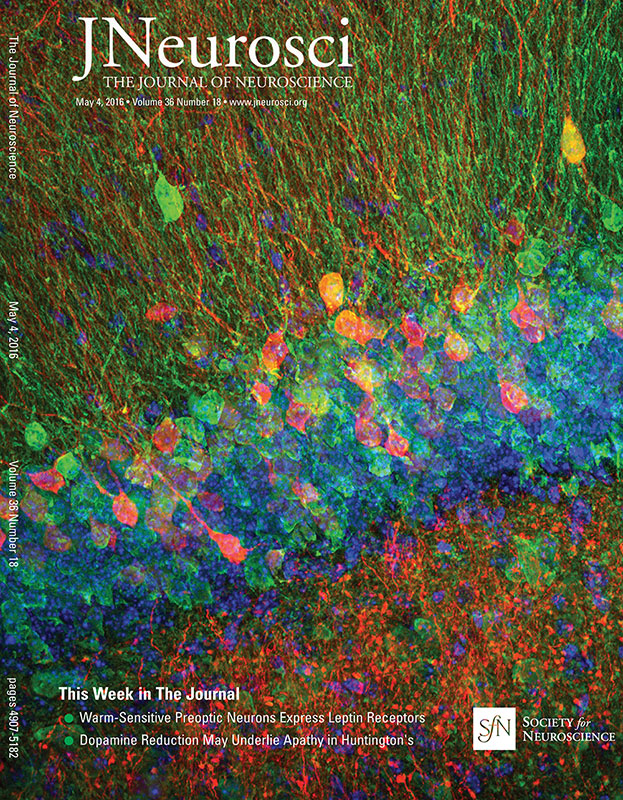The image is from their paper, “Trim9 Deletion Alters the Morphogenesis of Developing and Adult-Born Hippocampal Neurons and Impairs Spatial Learning and Memory, ” published in collaboration with Stephanie Gupton’s lab in the same edition.

Congratulations to Juan Song’s lab for having an image from a collaborative paper with Stephanie Gupton’s lab grace the cover of The Journal of Neurosciences’ May 4, 2016 edition! The paper, “Trim9 Deletion Alters the Morphogenesis of Developing and Adult-Born Hippocampal Neurons and Impairs Spatial Learning and Memory” was published in the same edition along with the cover.
The description of the cover image: This image shows dentate granule cells in the hippocampus of an adult mouse that lacks TRIM9 ubiquitin ligase. These cells, labeled with red and green florescent proteins, exhibit occasional ectopic migration into the molecular layer. For more information, see the article by Winkle, Olsen et al. (pages 4940–4958 on The Journal of Neuroscience website for it’s May 4, 2016 edition).
Abstract
“During hippocampal development, newly born neurons migrate to appropriate destinations, extend axons, and ramify dendritic arbors to establish functional circuitry. These developmental stages are recapitulated in the dentate gyrus of the adult hippocampus, where neurons are continuously generated and subsequently incorporate into existing, local circuitry. Here we demonstrate that the E3 ubiquitin ligase TRIM9 regulates these developmental stages in embryonic and adult-born mouse hippocampal neurons in vitro and in vivo. Embryonic hippocampal and adult-born dentate granule neurons lackingTrim9 exhibit several morphological defects, including excessive dendritic arborization. Although gross anatomy of the hippocampus was not detectably altered by Trim9 deletion, a significant number of Trim9−/− adult-born dentate neurons localized inappropriately. These morphological and localization defects of hippocampal neurons in Trim9−/− mice were associated with extreme deficits in spatial learning and memory, suggesting that TRIM9-directed neuronal morphogenesis may be involved in hippocampal-dependent behaviors.

SIGNIFICANCE STATEMENT Appropriate generation and incorporation of adult-born neurons in the dentate gyrus are critical for spatial learning and memory and other hippocampal functions. Here we identify the brain-enriched E3 ubiquitin ligase TRIM9 as a novel regulator of embryonic and adult hippocampal neuron shape acquisition and hippocampal-dependent behaviors. Genetic deletion of Trim9 elevated dendritic arborization of hippocampal neurons in vitro and in vivo. Adult-born dentate granule cells lacking Trim9 similarly exhibited excessive dendritic arborization and mislocalization of cell bodies in vivo. These cellular defects were associated with severe deficits in spatial learning and memory.” (~excepts from the paper published in The Journal of Neurosciences May 4, 2016.)
Cortney C. Winkle and Reid H. J. Olsen were joint first authors on the paper.
Read the full paper “Winkle, Olsen, et al., Trim9 Deletion Alters the Morphogenesis of Developing and Adult-Born Hippocampal Neurons and Impairs Spatial Learning and Memory, J. Neuroscience, 36(18): 4940-4958, 2016″, on The Journal of Neurosciences website.
